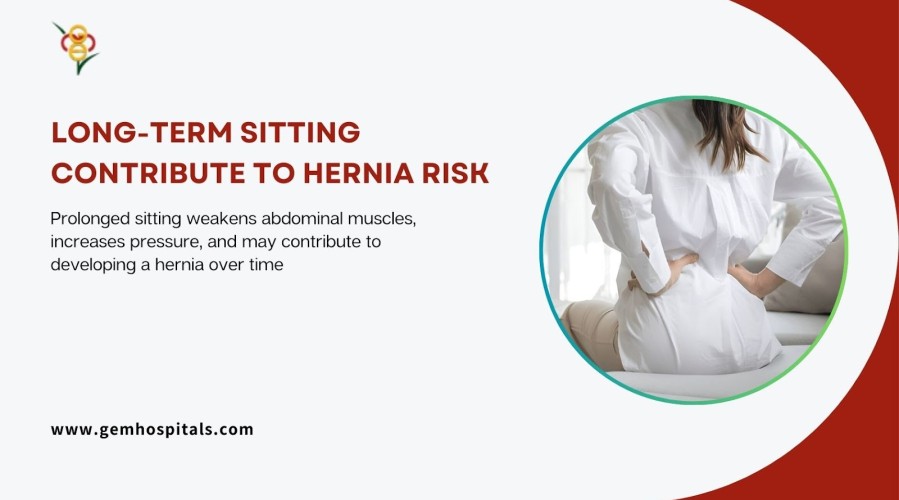Food poisoning is common during the monsoon. Learn when it becomes serious, how it can lead to pancreatitis or liver damage, warning signs, and when to seek medical care.
How Long-Term Sitting Can Contribute to Hernia Risk

In today’s society where most people work in an office environment and spend several hours in front of a computer, many people sit for hours. As simple as sitting may appear, data and health professionals recommend that extended sitting might lead to the development of a hernia. A hernia is a medical condition that is usually asymptomatic and only becomes apparent when complications arise and affects your life. Now let’s go deeper into how this standing threat is linked with sitting for long hours and what you can do to prevent it.
What Is a Hernia?
A hernia is a condition in which an organ or fatty tissue protrudes through a hole in the muscles or a membrane. This condition usually occurs in regions where muscles are relatively smaller and weaker, for example the groin or the abdominal wall. Common types of hernias include:
- Inguinal hernia: Located in the inguinal region and seen predominantly in males.
- Hiatal hernia: Happens when part of the stomach bulges into the chest cavity through the diaphragm.
- Umbilical hernia: Observed in the area of the umbilicus, may be present in children but also in grown-ups.
Hernias are most commonly due to weakness of the muscles and elevated pressure in the abdominal cavity. Although there are obvious causes such as lifting weights or coughing for long, sitting for long hours is now being acknowledged as a risk factor.
How Long-Term Sitting Affects Your Body
Staying for long hours in a chair has multiple impacts on your body particularly if you have a wrong posture or don’t get to stand up sometimes. These effects include:
- Weakening of muscles: Lack of exercise weakens the muscles in the abdomen and the core and these are important in offering support to the organs and to help prevent tissue from protruding through the muscles.
- Reduced circulation: Sitting causes the blood flow to decrease in the pelvic and abdominal areas. This can cause the muscles to become rigid, the muscles to atrophy and the tissues to break down over time.
- Postural strain: Sitting or leaning on furniture or chairs also puts pressure on the belly area due to improper sitting. This pressure can over time lead to a compromising of the integrity of the abdominal wall.
- Tight hip flexors: Staying for several hours contracts the hip flexor muscles which tilt the pelvis forward and put pressure on the lower abdomen muscles.
The Link Between Sitting and Hernia Risk
Although sitting does not contribute to hernias in a direct way it contributes to conditions that may lead to it. Here’s how:
- Weakened core muscles: Sitting for long hours results to muscle wastage mainly the muscles that are in the abdominal region. Inability to hold organs in the right positions also becomes a problem when these muscles are weak and this can lead to formation of a hernia.
- Increased abdominal pressure: The pressure within the abdomen rises when one is slouching or leaning forward most of the time. This pressure can cause tension on the areas of the abdominal wall which are already a little compromised and therefore prone to herniation.
- Weight gain: Inactivity causes the individual to put on weight, and this combined with pressure on the abdominal region will exacerbate the chances of a hernia.
Steps to Prevent Hernia Risk
The good news is that there are practical steps you can take to counter the negative effects of long-term sitting and reduce your risk of hernias:
- Incorporate movement into your day: One should not sit for long hours without standing up to stretch or move around. Take a break and stand up, stretch, or go for a walk every 30 minutes to help your blood flow and muscles.
- Strengthen your core muscles: Abdominal muscles are also protected by activities that involve the core, including planking, yoga, or Pilates, and can prevent muscle wastage.
- Maintain good posture: Make use of an ergonomic chair and try as much as possible to sit upright. Sit with your feet flat on the ground and do not hunch your shoulders or bend forward for any length of time.
- Adopt a healthy lifestyle: Eat well balanced diets and engage in physical activities to avoid gaining weight that puts pressure on the abdominal part of the body.
- Use ergonomic setups: Trying to work while sitting and standing at the same time can be effective, so, it is recommended to use standing desks or adjustable workstations.
Be Aware of Additional Risk Factors
However, it is necessary to underline that sitting is only one of the factors that can influence the development of a hernia. Other hazards include lack of physical activity, heavy lifting, chronic coughing or brisk physical activity after a long period of inactivity, all of which increase the risk of a hernia. Moreover, such states as obesity or chronic constipation, which increase intraabdominal pressure, will only worsen if a person spends a lot of time sitting.
When to Seek Medical Attention
Some of the signs include swelling, pain or discomfort in the abdomen or groin region and should be treated as an emergency. If this is diagnosed early and treated, it will not lead to other complications and the results will be much better.
It is sad to note that sitting for long hours has become the order of the day and therefore, it is crucial to master how it affects the body. Other causes of hernias include; poor muscle tone, poor blood circulation, and pressure on the abdomen from sitting for long hours. This risk can however be greatly minimized by continuing to be as active as possible, keeping good posture, and by doing exercises that work the muscles of the abdomen.
If you are worried about the hernia symptoms or if you need any consultation, do not delay. A visit to GEM Hospital will be helpful with the expert advice given. Book your appointment today!
Blogs & Article
UTI cases often rise during the rainy season. Learn why urology patients need extra precautions, common causes, symptoms, and prevention tips to stay healthy during monsoon.
Monsoon humidity can worsen endometriosis pain and bloating. Learn how weather changes affect symptoms and discover practical tips to manage discomfort during the rainy season.


